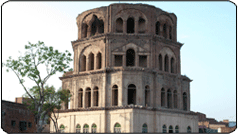Satkhanda / Naukhanda
'Some are born great, some achieve greatness and some have greatness thrust upon them' William Skakespeare-Twelfth Night.
There can be no better example of 'greatness thrust upon them' than the third King of Oudh (Awadh), Mohammed Ali Shah who was addressed in regalia as 'Abul Fateh Moinuddin Sultan-uz-zaman Nausherwan-e-Adil' besides the short title of 'Naseet-ud-Daulah'. He succeeded his nephew, King Naseer-ud-Din Haider, because the British Resident did not agree to recognise Fareidon Bakht alias Munna Jan, the son of the deceased King as the legitimate heir to the throne. On the very day that Munna Jan had been crowned the King, the British [deployed their forces and attacked the assembly at the Coronation Hall of the Lai Baradari and] dethroned him and installed Mohammed Ali as the third King of Oudh (Awadh) as they had planned.
The short reign of five years of Mohammed Ali Shah till his death in 1842 was very significant in many respects. The King, though infirm, ably managed the affairs of his administration, mostly on his own. He had the misfortune of having four Wazir (prime ministers) during this short reign. The King re-introduced the Amani system of collection of land revenue that was originally introduced by his father Nawab Saadat Ali Khan and soon managed to replenish the empty coffers of the treasury that he had inherited from Naseer-ud-Din Haider.
The British historian, Eliot has acknowledged the capabilities of Mohammed Ali Shah by recognising him as the 'initiator of administrative reforms in Oudh\ When the acting Resident Carfield attended the first anniversary of coronation of Mohammed Ali Shah, he was so impressed that in his letter to the Political Secretary to the government in Calcutta he referred to it as 'the sumptuous regalia of the palace'.
With his position established and constant flow of revenue having been maintained, the King diverted his attention to the glorification and beautification of the city and Hussainabad in particular, and also towards civic works of importance. He paid pound 3000 to the British for constructing the Lucknow-Kanpur road via Charbagh Bridge over the canal. Lieutenant Cunningham, an engineer, was appointed to supervise the construction of this road and other projects at the King's request. The King also constructed a wide pucca road from Dilkusha via Rumi Gate to Hussainabad along which he built the Chhota Imambara at Hussainabad and added many other exquisite buildings on either side, for beautification. These buildings and other earlier ones built by Asaf-ud-Daulah and the Nawabs made Lucknow a prominent picturesque city of the time and foreign visitors began calling it the 'Babylon of the East'.
The glorification of the city and its repeated reference to Babylon led the King Naseer-ud-Daulah to cherish the desire to build the tallest structure of the world, one that could be called the eighth wonder and something of the likeness of the Tower of Babel or the Leaning Tower of Pisa, of which he had heard so much from the visitors.
Munshi Ram Sahai Tamanna in his book Afzal-ut-Tawareekh published in 1871 records the laying of the foundation of Naukhanda and nearby Hussainabad talaab (a large water tank) in 1255 Hijri (1839) amongst the list of buildings of Mohammed Ali Shah. Naukhanda means a nine storeyed structure, but strangely most of the later writers refer to it as Satkhanda, a seven storeyed structure. In fact, today in Hussainabad area, only a four storeyed circular structure appears in existence (though Abdul Halim Sharar, the famous author of Guzishta Lucknowappears to have mentioned the completion of five storeys of Satkhanda in his book).
The Asiatic journal of 1816 refers to a six storeyed structure as 'the pagoda of Daulat Chhanah' (Daulat Khana) and its presence is further corroborated with a photograph of the Hussainabad area, which was taken from the top of the Rumi Gate in 1858. Obviously, with the existence of this six storeyed structure, the choice of the highest structure of the world by King Mohammmed Ali Shah would naturally fall for a much higher structure and as such it is the author's view that the structure was meant to be built as a Naukhanda and not Satkhanda. (Unfortunately, the said Daulat Khana tower has been demolished by the British after the annexation of Awadh).
Unlike his predecessors Ghazi-ud-din Haider and Naseer-ud-din Haider, the first and second Kings of Awadh, who were impressed by European architecture which they tried to emulate in their buildings, the third King Mohammed Ali Shah wanted to stick to the traditional Islamic and Moghul style of architecture. However, Naukhanda appears to have some exceptions. Here, along with the arches that are characteristic of the Islamic architecture, one also finds cornices and pediments that are triangular and speak of the Greek influence in the design. These may be seen in alternate succession in the facade and the four tiers of the structure that is extant today.
Source:
Times of India, Heritage
Monday 20.6.1994 — Naukhanda - the unfulfilled dream

